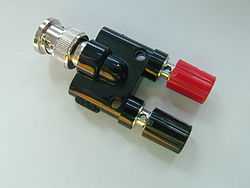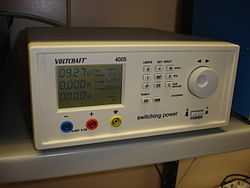Binding post




A binding post is a connector commonly used on electronic test equipment to terminate (attach) a single wire or test lead. They are also found on loudspeakers and audio amplifiers as well as other electrical equipment.
A binding post contains a central threaded metal rod and a cap that screws down on that rod. The cap is commonly insulated with plastic and color-coded: red commonly means an active or positive terminal; black indicates an inactive (reference or return) or negative terminal; and green indicates an earth (ground) terminal.
Commonly designed in a style called five-way or universal, such binding posts allow the connection of several different types of connections:
- Banana plugs, inserted into the open end of the binding post
- Pin connectors, inserted into a hole drilled through the metal post and clamped by the screw-down portion of the binding post.
- Bare wire inserted through the same hole and clamped, or
- Wrapped around the metal post and clamped.
- A lug terminal inserted around the metal post and clamped.
The binding post was a commercial invention of the General Radio Corporation.
Safety

In the past, it was common for multiple five-way binding posts to have their drilled holes lined up; this provided convenience in some applications as a bare wire could be strung from post to post to post. But this also impaired safety as two wires or pin connectors could be inserted from opposite sides of two binding posts and the tips of the wires or probes might inadvertently short together. Holes are now normally aligned in such a fashion that such shorts cannot occur.
Standard spacing
In order to permit the use of double banana plugs, the distance between the positive and negative plugs should be 3/4" (19 mm).
See also
- Fahnestock clip — an earlier device, now largely supplanted by binding posts
- Banana connector
External links
| |||||||||||||||||